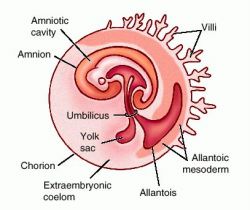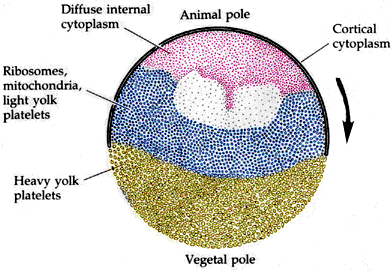Chapter 47 Vocabulary and Roots
Primitive streak: A thickening along the future anterior-posterior axis on the surface of an early avian or mammalian embryo, caused by a piling up of cells as they congregate at the midline before moving into the embryo.
Notochord: A longitudinal, flexible rod made of tightly packed mesodermal cells, that runs along the anterior-posterior axis of a chordate in the dorsal part of the body.
Dorsal lip: The region above the blastopore on the dorsal side of the amphibian embryo.
Blastopore: In a gastrula, the opening of the archenteron that typically develops into the anus in deuterostomes and the mouth in protostomes.
Archenteron: The endoderm-lined cavity, formed during the gastrulation process, that develops into the digestive tract of an animal.
Gastrula: An embryonic stage in animal development encompassing the formation of three layers: ectoderm, mesoderm, and endoderm.
Holoblastic cleavage: A type of cleavage in which there is complete division of the egg; occurs in eggs that have little yolk (such as those of a sea urchin) or a moderate amount of yolk (such as those of the frog). 
Meroblastic cleavage: A type of cleavage where there is incomplete division of yolk-rich egg, characteristic of avian development. 
Chorion: The outermost of four extraembryonic membranes. It functions in gas exchange and contributes to the formation of the mammalian placenta.
Blastomeres: An early embryonic cell arising during the cleavage stage of an early embryo.
Yolk: Nutrients stored in an egg.
Vegetal pole: The point at the end of an egg in the hemisphere where most yolk is concentrated; opposite of animal pole.
Animal pole: The point at the end of an egg in the hemisphe
re where the least yolk is concentrated; opposite of vegetal pole.
Gray crescent: A light gray, crescent-shaped region of cytoplasm that becomes exposed after cortical rotation, located near the equator of an egg on the side opposite sperm entry, marking the future dorsal side of the embryo.
Morula: An embryo at an early stage of embryonic development, consisting of cells in a solid ball contained within the zona pellucid.
Blastocoel: The fluid-filled cavity that forms in the center of a blastula.
Blastula: A hollow ball of cells that marks the end of the cleavage stage during early embryonic development in animals.
Roots:
zona- a belt noto- the back arch-ancient
morul- a little mulberry involut-wrapped up blast-bud, sprout
cortex- shell fertil- fruitful gastro-stomach
holo- whole







No comments:
Post a Comment